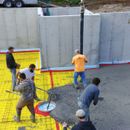Vapor barrier
I just poured the basement slab of a new home I am building. My GC chose to pour the slab before placing the basement columns (posts). The concrete contractor used circular sonotubes instead of boxing out the location above the footing piers (helps prevent cracks in slab). My GC added sealer tap from the vapor sheeting to each sonotube. The plan is to place the posts and add foamboard and vapor sheeting inside each sonotube and sealing around each post.
Will this create a continuous vapor barrier?
GBA Detail Library
A collection of one thousand construction details organized by climate and house part










Replies
Dwayne,
I'm not sure what "sealer tap" is. Perhaps you meant to write "sealer tape"?
What do you mean when you write that "the plan is to ... add foamboard and vapor sheeting inside each Sonotube"? Do you mean that workers inserted vertical foam board inside the cardboard tube before the concrete was placed in the Sonotube? That's hard to visualize.
[Later edit.] Perhaps you mean that a circle of horizontal foam board was placed inside the Sonotube after the concrete was placed? If that's what you mean, will the post bear on the concrete? (That would require removing the center of the horizontal foam, creating a donut.)
Hi Martin,
Yes, sealer tape or mastic tape? This is the red tape from the yellow poly sheeting to each sonotube. I should clarify, the gravel sub grade is first covered wall to wall with foam board. The foam board was completely sealed with Dow mastic tape on every seam. On top of the foam board is the yellow polly sheeting sealed along every seam with red mastic tape. The cement contractor cut the circular opening out from each sonotube to place the sonotube flush against the footing pier. However, he reused the blue foam board inside each sonotube, to support the tube against the weight of the cement. My GC has since removed the foam inside each sonotube to reveal the top of each footing pier (perfectly centered and no gravel is visible).
All the post will now be placed directly in the middle of each sonotube directly on top of the cement footing pier. When the garage slab is poured, the inside of each sonotube will be filled with cement around each posts.
I've been told the sonotubes are used in commercial buildings. Since they are directly on top of each footing pier, the vapor seal should still be intact. I was thinking about adding foam and poly inside each sonotube before they add the cement, just to be safe.
Thanks
Dwayne,
It sounds like each post will be surrounded by concrete, so I'm assuming that you are talking about steel lally columns, not wood posts.
The bottom line is, "Don't worry." If a vapor barrier has holes amounting to 5% of the area of the floor -- and yours will be much better than that -- it will still be 95% effective. You don't have to worry about water vapor transmission through this floor assembly.
If you are worried about soil gasses like radon, or air infiltration through the slab, you can always caulk the crack between the slab and the posts after the concrete is cured.